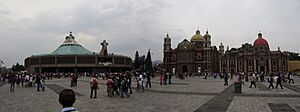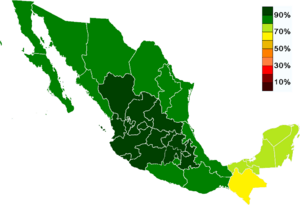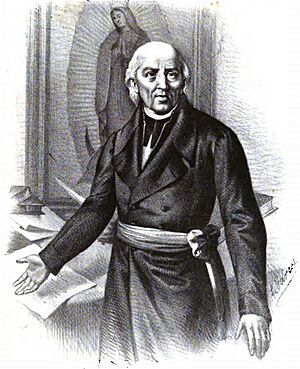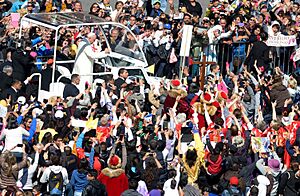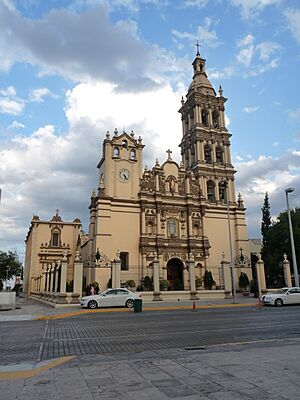Catholic Church in Mexico facts for kids
Quick facts for kids Catholic Church in Mexico |
|
|---|---|
| Spanish: Iglesia Católica en México | |
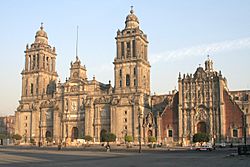
|
|
| Type | National polity |
| Classification | Catholic |
| Orientation | Roman Catholic |
| Scripture | Bible |
| Theology | Catholic theology |
| Polity | Episcopal |
| Governance | CEM |
| Pope | Francis |
| President | Francisco Robles Ortega |
| Region | Mexico |
| Language | Spanish, Latin |
| Founder | Juan de Zumárraga |
| Origin | Early 16th Century New Spain, Spanish Empire |
| Separations | Protestantism in Mexico |
| Members | 97,864,220 (2020) |
The Catholic Church in Mexico is a big part of the worldwide Catholic Church. It follows the spiritual lead of the Pope in Rome. It also has its own group of leaders in Mexico called the Mexican Episcopal Conference.
Most people in Mexico are Catholic. In 2020, about 77.7% of the population said they were Catholic. This makes Mexico one of the countries with the most Catholics in the world.
The story of the Catholic Church in Mexico began a long time ago. It started when the Spanish arrived in Mexico in the early 1500s. Over time, the Church became a very important part of Mexican life and culture.
Sometimes, Catholic beliefs in Mexico mix with older local customs. These customs come from ancient Aztec, Mayan, and other native religions.
Contents
How Did the Catholic Church Start in Mexico?
The history of the Catholic Church in Mexico can be split into two main parts. The first part is when Mexico was a Spanish colony, called New Spain. This period lasted until 1821. The second part is after Mexico became an independent country.
When the Spanish first arrived in the early 1500s, they wanted to teach the native people about Christianity. This big effort was called "the spiritual conquest." As the Spanish Empire grew, bringing the native people into the Church was very important to the Spanish rulers.
As more Spanish and mixed-race people lived in cities, the Church set up bishops and dioceses. These were like local church areas, and the Spanish king had a lot of say in how they were run.
After Mexico became independent in the early 1800s, the Catholic Church kept its special status. It was the official and only religion allowed by law. But in the 1850s, there was a big conflict called La Reforma. Some people, called liberals, wanted to reduce the Church's power. This led to a long period of fighting.
Later, after the Mexican Revolution, the Church's role was limited by new laws. These laws were made by leaders who wanted less church influence in government.
After some more conflict, the Church and the government found a way to get along. Even though the laws limiting the Church stayed, the Church was able to do more. It started more religious schools and a conservative political party.
In 1992, new laws were made that clearly separated the Church and the government. These new laws also gave more freedom for religious activities in Mexico.
How Is the Church Organized in Mexico Today?
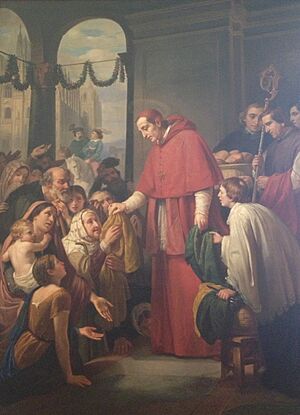
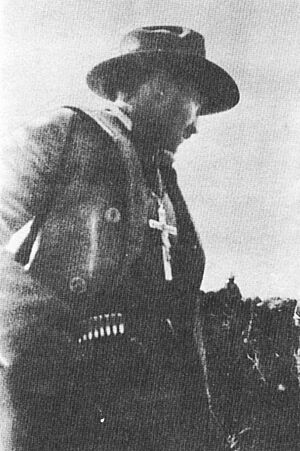
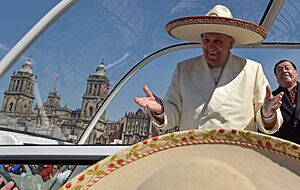
The Catholic Church is the largest Christian church in the world. In 2020, Mexico had about 97.8 million Catholics. This makes it the second-largest Catholic country after Brazil.
Mexico is divided into 18 large church regions called Ecclesiastical provinces. These regions contain a total of 90 smaller areas called dioceses. There are many priests and people in religious orders working in Mexico.
Important leaders in the Church are called cardinals. José Garibi y Rivera was the first Mexican cardinal. More recently, Pope Francis has chosen new cardinals from Mexico. For example, Alberto Suárez Inda became a cardinal in 2015. He is known for helping to solve problems in one of Mexico's most troubled states. In 2017, Cardinal Carlos Aguiar Retes became the Archbishop of Mexico City.
Church Regions in Mexico
Mexico's church regions are organized into metropolitan archdioceses and their smaller dioceses. Here are some of them:
- Metropolitan Archdiocese of Acapulco
* Diocese of Chilpancingo-Chilapa * Diocese of Ciudad Altamirano * Diocese of Tlapa
- Metropolitan Archdiocese of Antequera, Oaxaca
* Diocese of Puerto Escondido * Diocese of Tehuantepec * Diocese of Tuxtepec * Prelature of Huautla * Prelature of Mixes
- Metropolitan Archdiocese of Chihuahua
* Diocese of Ciudad Juárez * Diocese of Cuauhtémoc-Madera * Diocese of Nuevo Casas Grandes * Diocese of Parral * Diocese of Tarahumara
- Metropolitan Archdiocese of Durango
* Diocese of Gómez Palacio * Diocese of Mazatlán * Diocese of Torreón * Prelature of El Salto
- Metropolitan Archdiocese of Guadalajara
* Diocese of Aguascalientes * Diocese of Autlán * Diocese of Ciudad Guzmán * Diocese of Colima * Diocese of San Juan de los Lagos * Diocese of Tepic * Prelature of Jesús María
- Metropolitan Archdiocese of Hermosillo
* Diocese of Ciudad Obregón * Diocese of Culiacán * Diocese of Nogales
- Metropolitan Archdiocese of Xalapa
* Diocese of Coatzacoalcos * Diocese of Córdoba * Diocese of Orizaba * Diocese of Papantla * Diocese of San Andrés Tuxtla * Diocese of Tuxpan * Diocese of Veracruz
- Metropolitan Archdiocese of León
* Diocese of Celaya * Diocese of Irapuato * Diocese of Querétaro
- Metropolitan Archdiocese of Mexico
* Diocese of Azcapotzalco * Diocese of Iztapalapa * Diocese of Xochimilco
- Metropolitan Archdiocese of Monterrey
* Diocese of Ciudad Victoria * Diocese of Linares * Diocese of Matamoros * Diocese of Nuevo Laredo * Diocese of Piedras Negras * Diocese of Saltillo * Diocese of Tampico
- Metropolitan Archdiocese of Morelia
* Diocese of Apatzingan * Diocese of Ciudad Lázaro Cárdenas * Diocese of Tacámbaro * Diocese of Zamora
- Archdiocese of Puebla de los Angeles
* Diocese of Huajuapan de León * Diocese of Tehuacán * Diocese of Tlaxcala
- Metropolitan Archdiocese of San Luis Potosí
* Diocese of Ciudad Valles * Diocese of Matehuala * Diocese of Zacatecas
- Metropolitan Archdiocese of Toluca
* Diocese of Atlacomulco * Diocese of Cuernavaca * Diocese of Tenancingo
- Metropolitan Archdiocese of Tijuana
* Diocese of La Paz * Diocese of Mexicali * Diocese of Ensenada
- Metropolitan Archdiocese of Tlalnepantla
* Diocese of Cuautitlán * Diocese of Ecatepec * Diocese of Izcalli * Diocese of Netzahualcóyotl * Diocese of Teotihuacan * Diocese of Texcoco * Diocese of Valle de Chalco
- Metropolitan Archdiocese of Tulancingo
* Diocese of Huejutla * Diocese of Tula
- Metropolitan Archdiocese of Tuxtla Gutiérrez
* Diocese of San Cristóbal de Las Casas * Diocese of Tapachula
- Metropolitan Archdiocese of Yucatán
* Diocese of Campeche * Diocese of Tabasco * Prelature of Cancún-Chetumal
Other Catholic Groups in Mexico
Besides the main Latin Church, there are also other Catholic groups in Mexico. These groups follow different traditions but are still part of the worldwide Catholic Church. They include:
- The Maronite Catholic Eparchy of Our Lady of the Martyrs of Lebanon in Mexico
- The Melkite Greek Catholic Eparchy of Nuestra Señora del Paraíso in Mexico City
- The Armenian Catholic Apostolic Exarchate of Latin America and Mexico
There are also religious orders like the Missionary Sons of the Immaculate Heart of Mary, also known as the Claretian Order.
Images for kids
See also
 In Spanish: Iglesia católica en México para niños
In Spanish: Iglesia católica en México para niños



